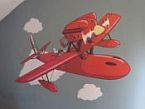wneumann
Posts: 3768
Joined: 11/1/2005
From: just beyond the outskirts of Margaritaville
Status: offline

|
quote:
2. Does "ground attack" type actually effect anything? Training bomber pilots to ground attack, port attack, or airfield attack has the same visible effect in that they all increase the ground attack skill. I wonder, because I do not know, if there is a behind the scenes effect depending on the mission type.
Ground attack training will prepare bomber pilots for attack on all "land" targets - airfields. ports, city (strategic bombing), LCU's. I also train ground attack pilots on low level ground attack (LowG) skill as much as possible to where pilots have 70 skill level in both GrdB and LowG skills. The seoond level of training provides some bump in pilot experience and defensive skills. It also creates bomber pilots that can be most effectively employed against any type of ground target at any given altitude.
I also employ a similar technique on training pilots for bombing (not torpedo) naval targets. These pilots trained to 70 skill levels in both naval bombing (NavB) and low-level naval bombing (LowN) plus naval search. The two latter skills are important for training pilots to be used in 2E attack bomber "skip bombing" missions against ship targets. Torpedo bomber pilots handled differently, 70 skill levels in torpedo bombing (NavT) and naval search.
While this method does generate highly specialized pilots for any particular type of bombing attack, it allows for little if any cross-training. What this training method usually produces is front-line bomber squadrons that are specialized in attacking specific target type(s). Both an asset and a liability.
quote:
3. Similar to the second question, is there any value to training "night" pilots? Training during the day or night has the same visible effect in that it increases whatever skill is being trained. When I first started playing I did specifically train pilots for night missions; however, since there is only one "phase" of night air missions, I found this to be less effective (as far as visible skill increase goes) than training all pilots during the day.
Fully trained fighter pilots are usable in both "day" and night fighter units drawing from a common pool of trained pilots. If using night fighter air units for pilot training, set them to train in Strafing skill (they seem to work more effectively in this mode).
quote:
4. Is it better to concentrate solely on training mission skills for fighter pilots, or should I mix in some cap to my training missions? Currently I train as follows:
Dedicated: Air skill trainer, strafe trainer, cap trainer.
I train the pilots in either air or strafe squadrons once they hit 70 in the skill I flip squadrons until I have pilots around 70 air, 70 strafe, 70 defense. I then plop them into the cap squadrons and run cap missions until their overall experience is somewhere between 65 and 70 (depends on how badly I need pilot replacements).
That said, it occurs to me that there is duplication of effort because just flying cap also raises overall air skill.
I use the same (3-stage) training process for fighter pilots (Air, Strafe, CAP). Dedicated training squadrons for each skill the way to go, rotating pilots between squsdrons (via the Reserve pilot pool) as they complete training in each skill. Sequence of skills is not critical though I train CAP only for pilots that have completed training for both Air and Strafe skills (this strictly for organization purposes).
Note the use of dedicated training squadrons is also true for bomber pilots. Two things should be taken into account when using dedicated training squadrons: (1) you'll need a lot of air units for training and (2) when training pilots in two or more skills, make sure you have air units set to train pilots in each skill and that the number of training squadrons for each skill is balanced to prevent bottlenecks.
< Message edited by wneumann -- 1/13/2017 3:49:32 PM >
|
 Printable Version
Printable Version















 New Messages
New Messages No New Messages
No New Messages Hot Topic w/ New Messages
Hot Topic w/ New Messages Hot Topic w/o New Messages
Hot Topic w/o New Messages Locked w/ New Messages
Locked w/ New Messages Locked w/o New Messages
Locked w/o New Messages Post New Thread
Post New Thread